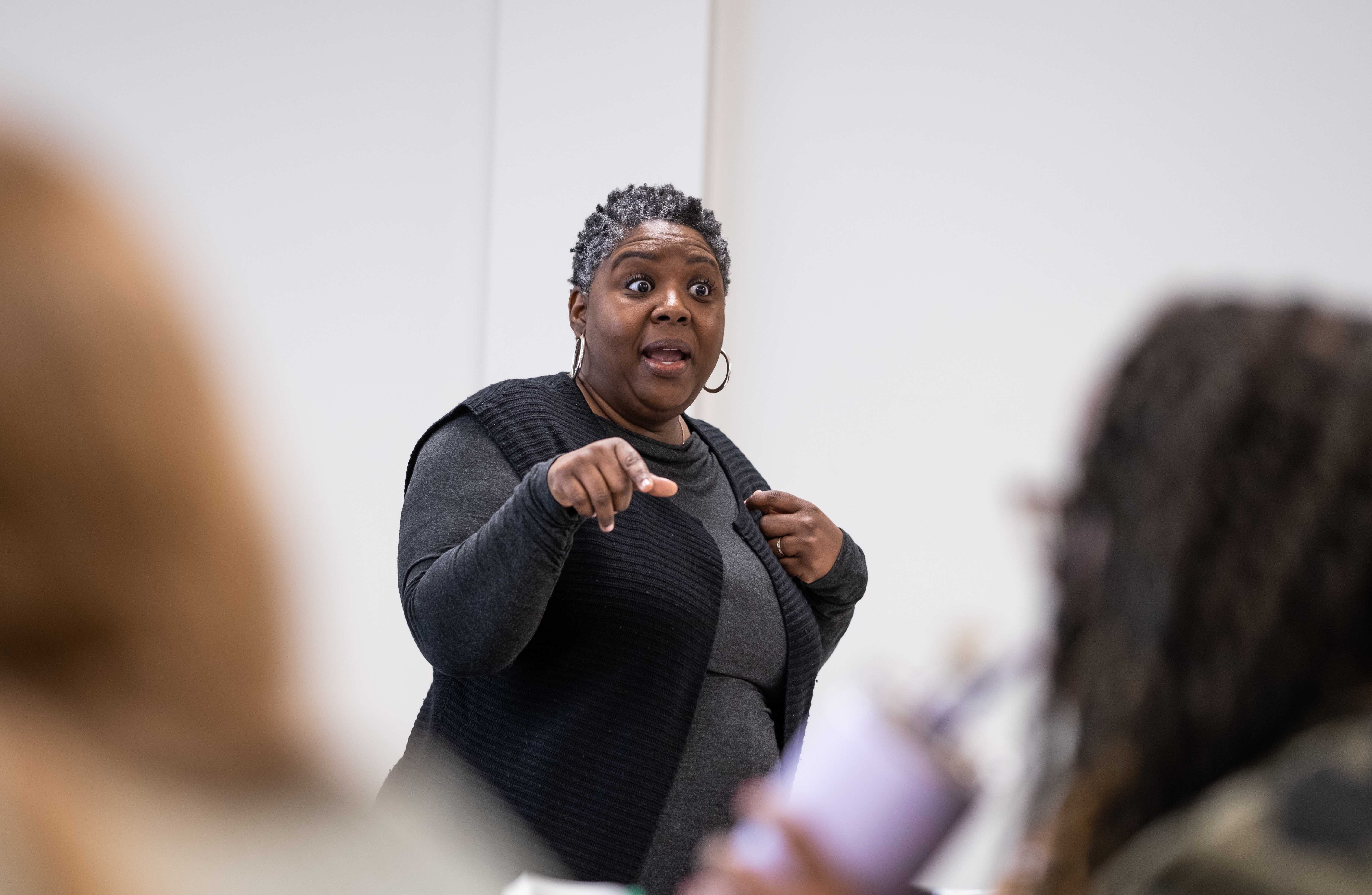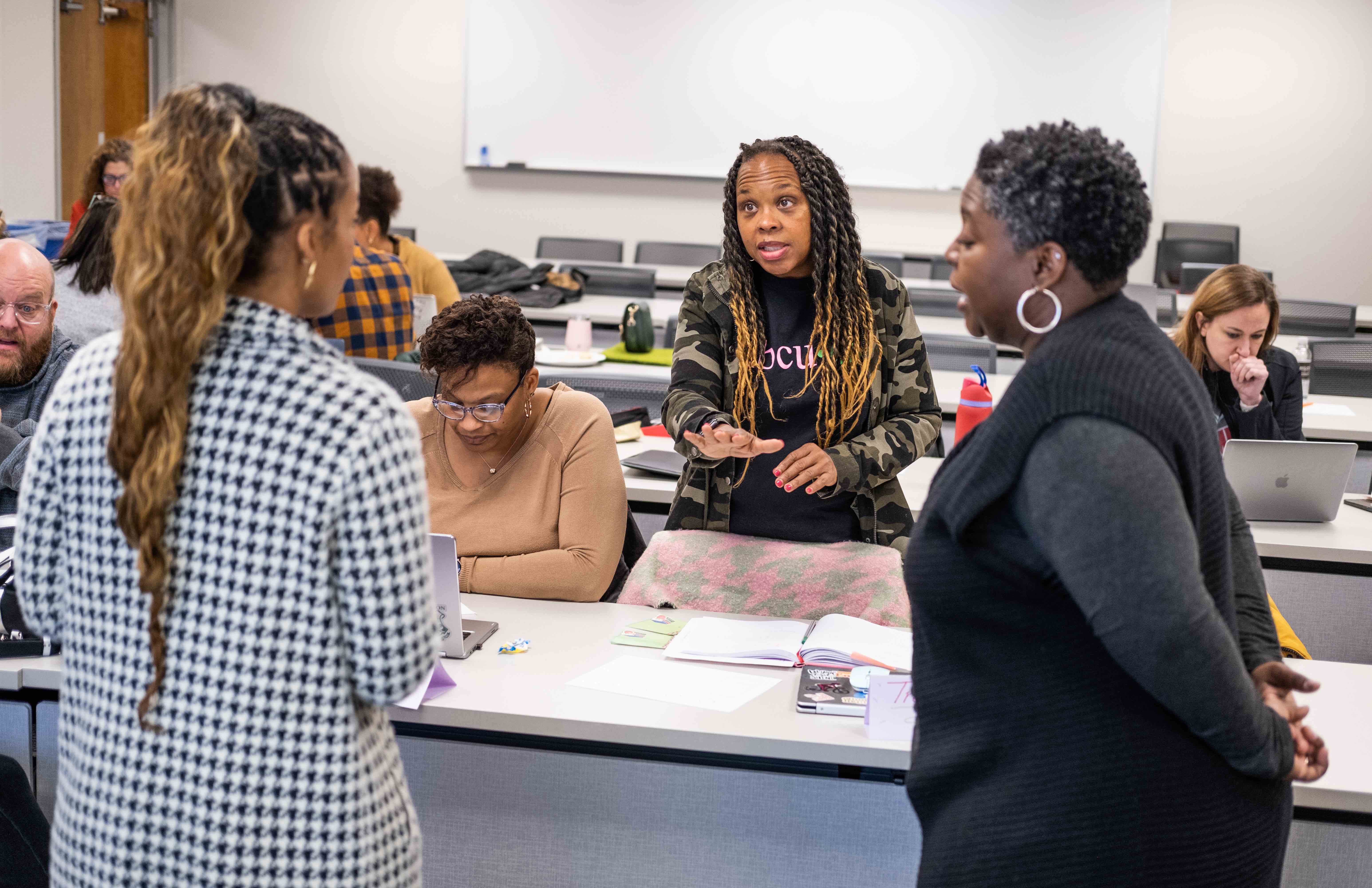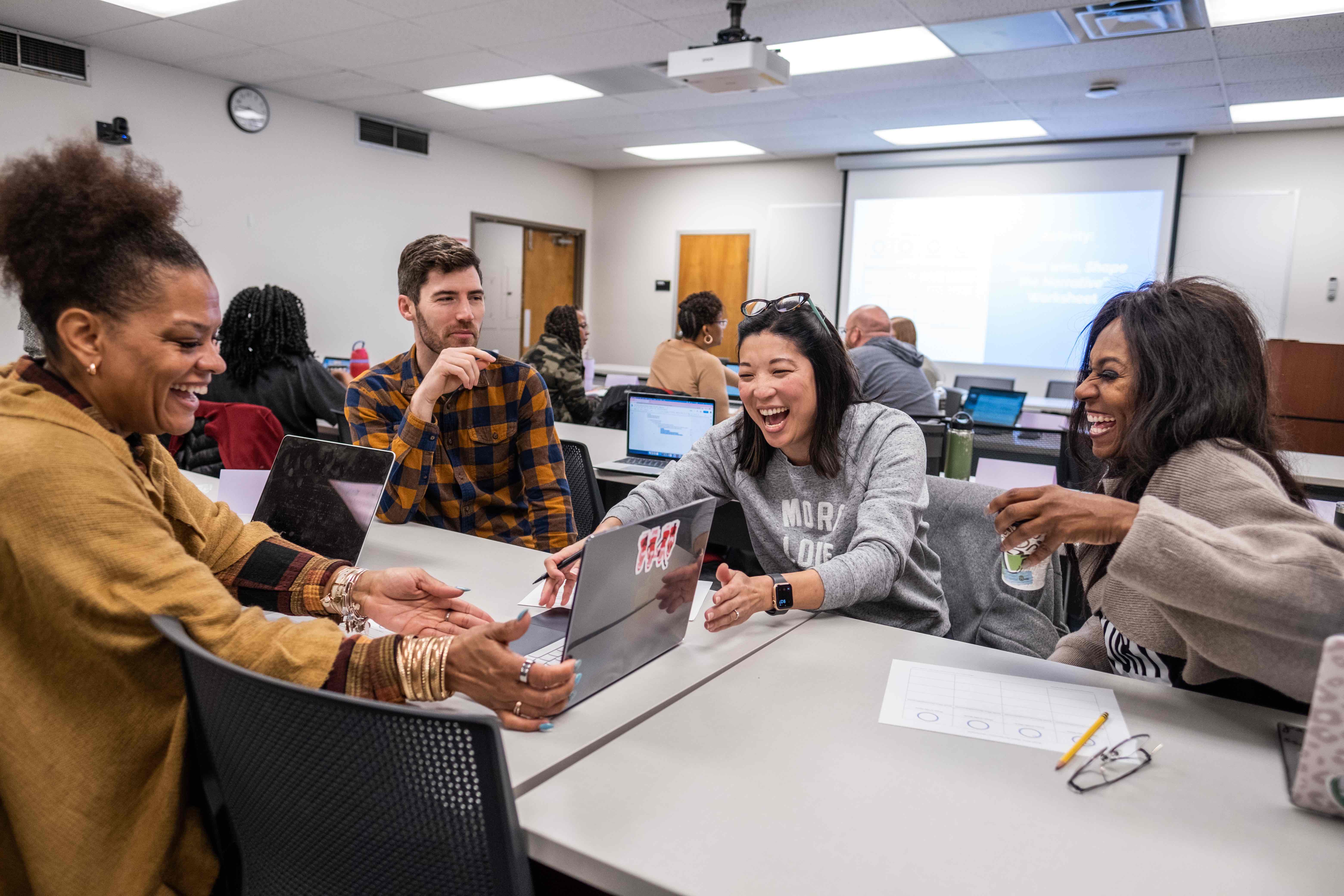
Worthington City Schools' Angela Adrean, Kelly Wegley (director of academic achievement and professional learning) and Toya Spencer
After summerlong protests rocked the nation in 2020, school districts around the country worked to address racial disparities in their education communities. That fall, many school boards — including some throughout Ohio — signaled their commitment by hiring diversity officers to focus on equity and inclusion. Toya Spencer was one of them.
“Many organizations were pledging to do all of these grand things around social justice,” said Spencer, director of diversity, equity and inclusion at Worthington City Schools. “That also was a time people were putting up the black squares on their social media.”
Spencer had worked as a diversity officer in the corporate world for years. But after George Floyd’s murder, she saw a rush by corporations to add similar positions to their teams.
“Then school districts followed suit,” she said. “Many of them said, ‘We need to create this role so that someone can lead this work.’ In most cases it was starting the work because there weren't robust DEI efforts and programs prior to 2020.”
Three years later, many school equity officers have had mixed success. Some met with backlash even before they started. Others have battled the inertia of school boards and administrators. Some, new to the field, lacked direction. Turnover in the positions has been high.
Spencer has experienced none of those outcomes.
“I have yet to encounter a district that does not want equity and inclusion in their schools,” said Noelle Arnold, senior associate dean at the College of Education and Human Ecology who has partnered with Worthington Schools on equity efforts through a college training program. “A lot of districts want students to have equitable chances of success, belonging and well-being. Worthington has been a real model of K-12 inclusive excellence.”

What has made the difference?
Though historically a predominantly white district, the suburban Worthington City Schools are now in fact quite diverse: 40% of its pupils are students of color, and the student body comes from 85 different countries.
“So, it's critical that we, as educators, evolve and adapt and learn more, to better meet the needs of the students that we serve,” said Superintendent Trent Bowers, ’01 MA.
Equity efforts were underway well before Spencer began her position, Bowers said. Employees had received implicit bias training and were implementing culturally responsive teaching methods. Professor and Chair of the Department of Teaching and Learning Antoinette Miranda provided training on cultural empathy.
“There was a really strong foundation … already laid with our staff that allowed Toya then to come in and build upon that,” Bowers said.
A core committee had been established to develop DEI strategy, and some principals had begun implementing it. All five elected school board members were aligned with the DEI goals signaled by Bowers and Assistant Superintendent Angela Adrean.
“In this political environment, that can be challenging in communities,” Bowers said.
Looking at the district’s progress, Spencer read the DEI tea leaves when she applied for the job.
“I was interested in the role because it wasn't purely a reactionary response to what was occurring in our country and our community,” she said.
Positioning DEI matters
Spencer had worked for nine years as a diversity and inclusion manager for corporations, including Huntington Bank and retailer Abercrombie and Fitch. She knew how to create a DEI strategy, manage training and influence policy. What she didn’t know was education.
“I remember sitting down and saying, ‘All I really want you to do right now is just build relationships,” said Angela Adrean, assistant superintendent of Worthington City Schools who supervises Spencer and academic directors. “She wasn't familiar with the acronyms that we use in education — the educational jargon. And, so, I just wanted her to really spend a year to get to know what it feels like to live in a school district and build relationships with people.”
Some felt that Spencer’s position should sit outside of the district’s organizational chart, reporting only to the board or to Bowers, to give her more autonomy to act. Instead, Bowers and Adrean chose to embed the position into the academic team, “so that work is then baked into that team,” Bowers said. “It's not separate from that team. I think that's been a big piece of our success.”
Spencer had a seat at the table, and instant guides on education matters among the academic directors and with Adrean, herself a career educator and school administrator.
“My peers are the director of elementary education, the director of secondary education, the director of special education,” Spencer said. “Having this ability to be shoulder to shoulder and next to them has been greatly beneficial because they are also taking ownership of the work. I was invited into the meetings with our principals to understand what this work looks like in their buildings.”

Unique training opportunity from Ohio State
To shore up her knowledge about diversity in education, in 2021 Spencer joined the first cohort of the Leading Anti-Racism Change in Education Summer Institute, a partnership between Ohio State’s College of Education and Human Ecology and Fisher College of Business. Funded by a seed grant from the university’s Office of Diversity and Inclusion, the program was among the first to provide comprehensive equity training geared to school diversity officers.
“For me, it was perfect, because we talked about the issues that are in public education,” Spencer said.
Throughout the school year, program mentors met monthly with participants to guide them if they hit snags or needed help with next steps. Education and Human Ecology’s Carlotta Penn and Professor Stephanie Power-Carter, and Fisher College’s Associate Professor Tracy Owens and Professor Tanya Menon were among the instructors.
“I loved the approach. The program’s aim was to help us create a strategy for our district,” she said. “For me, Tracy Owens and Tanya Menon were speaking my language. I just needed to understand, what does this look like in the context of a public school?”
She was mentored by both Adam Shank, executive director of the Ohio Alliance of Boys and Girls Clubs, and Noelle Arnold, from Ohio State. Shank gave feedback on the district’s DEI strategies. Arnold met with the school board, helped guide communications strategies and advised on ways to measure equity gaps.
Penn, the college’s senior director of partnerships and engagement and a former literacy trainer, helped Worthington’s high school language arts teachers evaluate reading materials for inclusive themes.
“What I found was a team of people who were willing to say, ‘We're going to support you all in your work in Worthington,’” Spencer said. “They partnered with us. I will be an ambassador for that program any day.”
Making progress
Arnold advised the district on alternative ways to assess its equity needs, rather than using an external equity audit, which can be pricey. They instead chose a free tool from the Ohio Department of Education. The tool measures equity gaps — using data the district already has — in areas like family and community engagement, school climate and student access. From there, Spencer created an equity scorecard, which uses the data to measure progress on DEI priorities.
“A lot of corporations have diversity scorecards, but I haven't heard of any other school districts creating a scorecard, and one that allows districts to continuously see where they are based on their own equity goals,” Arnold said. “That type of creativity and commitment from the district has made our partnership so fruitful. I think that has made the difference.”
Adrean and Spencer discuss the data quarterly: How many students of color are in advanced placement courses? Are they involved in athletics, or taking advantage of extra-curricular activities?
“We feel, on an ongoing basis, we need to be able to look at those six key points on the (state) strategic plan … and say, ‘Where do we score on this along the way?’” Adrean said. “It created this self-assessment for our district so that we know where we've been successful and where we may need to do better.”
Recognizing that Spencer can’t go it alone, the district has brought others into the work as well. It creates positions of DEI “champions,” mostly teachers who earn stipends to head up equity work in each building. Spencer trains them. They meet regularly to discuss white papers or book chapters. She coaches them on how best to navigate difficult conversations.
“We role play situations that they have encountered, in their buildings or outside of work,” Spencer said. “We process through, how do I have this conversation using these tools that we have learned? … We're trying to help people grow on what I call their inclusion journeys. How we approach these conversations is very important.”

Messaging matters
Spencer’s newsletters, videos and the district’s DEI website all include the statement, “Everyone feeling like they're seen, valued and heard.” The branding is intentional. She often reflects on Gardenswartz and Rowe’s 24 Dimensions of Diversity as she writes or speaks to families. True diversity includes gender perspectives, religious perspectives, disability perspectives as well as racial perspectives.
“Many people could look at me and think that when I talk about diversity, I only mean Black and white,” she said. “That's not what I mean. I (am) aware of that reality and very intentional about describing what diversity is and who is a part of that conversation.”
“I think most people can relate at some point in their lives to feeling like they didn't belong somewhere — feeling like they were in the out group as opposed to the in group,” she said. “People can relate to that. That's inclusion. … If you approach diversity in that way, many more people can see themselves being a part of the conversation.”
Arnold has cautioned the district not to tackle too much change at once. That approach has overwhelmed many well-meaning districts. So, some people might be frustrated at the pace of change, Bowers said.
“If you really want change to happen, it's a slow process,” he said. “We have 1,325 employees. We're trying to impact every one of their hearts and minds — not trying to just check a box that says we did ‘x’ so that we can say we did ‘x.’”
Twice a month, Spencer sits in a rocking chair and channels her inner LeVar Burton. “Ms. Toya” reads books about Kwanza or autism to elementary students, DEI’s youngest beneficiaries. Reading books that reflect who children are is among her favorite duties. In that moment, Spencer could hardly be further from the corporate world where she spent much of her career. But her intentions remain the same.
Everyone feeling like they're seen, valued and heard.
